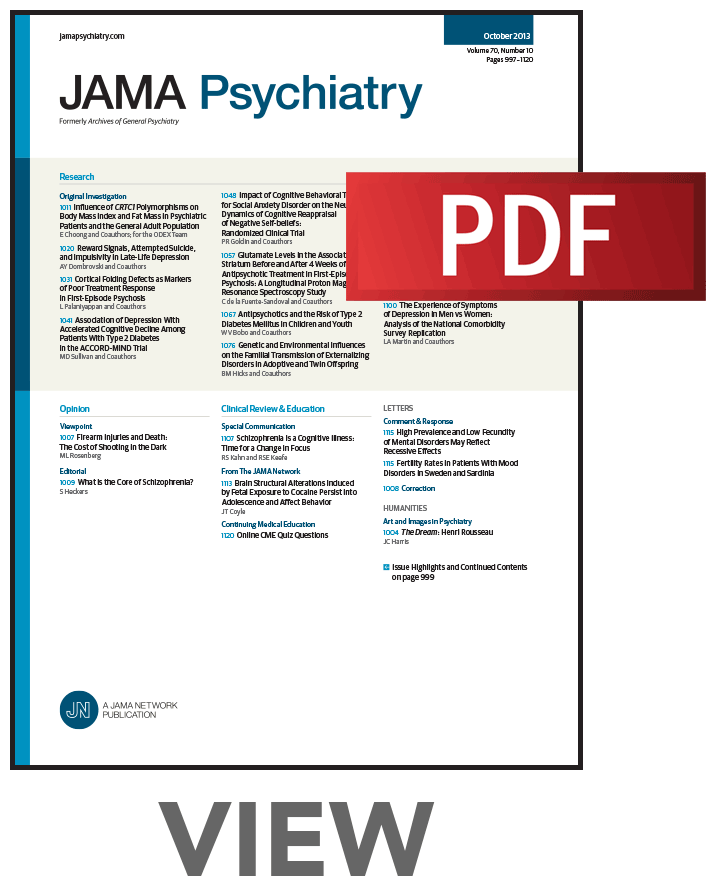Efficacy and Safety of Seltorexant in Insomnia Disorder: A Randomized Clinical Trial.
IF 17.1
1区 医学
Q1 PSYCHIATRY
引用次数: 0
Abstract
Importance Existing pharmacological treatments for insomnia have significant limitations. Objective To assess the effective dose range, safety, and tolerability of the novel selective orexin-2 receptor antagonist seltorexant in insomnia disorder. Design, Setting, and Participants This randomized, double-blind, active- and placebo-controlled, dose-finding, polysomnography study was conducted from November 2017 to April 2019 at 55 sites in 6 countries and analyzed in August 2019. The timeline for submission of this data for publication was impacted by internal strategic decision-making. Adults (aged 18-64 years) and older adults (aged 65-85 years) with insomnia (Insomnia Severity Index score ≥15) and no psychiatric comorbidity were included. Interventions Participants were randomized 1:1:1:1:1 to receive nightly oral-seltorexant (5 mg, 10 mg, or 20 mg), placebo, or zolpidem (5-10 mg) for 14 days. Main Outcomes and Measures Primary and key secondary outcomes included the dose-response relationship of night 1 latency to persistent sleep (LPS) and wake after sleep onset over the first 6 hours (WASO-6). Other secondary outcomes included night 13 LPS and WASO-6. Due to asymmetrical distributions of LPS and WASO-6 at baseline, log transformation was applied and results were expressed as back-transformed least-squares mean (LSM) ratios for comparisons between groups. Results Overall, 364 participants (mean [SD] age, 57.8 [12.4] years; 246 [67.6%] female) received seltorexant, 5 mg (n = 71), 10 mg (n = 74), or 20 mg (n = 71); placebo (n = 75); or zolpidem (n = 73). The night 1 dose-response relationship for LPS was significant (with trend test t statistics ≥3.99 and adjusted P values <.001 for all 4 prespecified models), with greater improvements in seltorexant, 10 mg and 20 mg, vs placebo (10 mg: LSM ratio, 0.64; 90% CI, 0.51-0.81; 20 mg: LSM ratio, 0.51; 90% CI, 0.41-0.64) and in seltorexant, 20 mg, vs zolpidem (LSM ratio, 0.71; 90% CI, 0.57-0.88). The night 1 dose-response relationship for WASO-6 was also significant, with trend test t statistics ≥3.99 and adjusted P values <.001 for all 4 prespecified models (seltorexant, 10 mg: LSM ratio, 0.68; 90% CI, 0.55-0.85; seltorexant, 20 mg: LSM ratio, 0.60; 90% CI, 0.48-0.74). Night 1 LPS and WASO-6 improvements were maintained on night 13 for seltorexant, 10 mg and 20 mg, but diminished for zolpidem. On night 13, compared with zolpidem, seltorexant, 10 mg and 20 mg, improved LPS by 30% and 28%, respectively, and seltorexant, 20 mg, improved WASO-6 by 31%. Treatment-emergent adverse events (TEAEs) were lower across the combined seltorexant doses (73/216 [33.8%]) relative to placebo (37/75 [49.3%]) and zolpidem (31/73 [42.5%]). Two participants experienced serious TEAEs during the double-blind phase (1 in the seltorexant, 20 mg, group and 1 in the zolpidem group). Three participants in the seltorexant, 5 mg, and 1 in the seltorexant, 20 mg, group experienced asymptomatic electrocardiogram-related TEAEs leading to discontinuation. Conclusions and Relevance Among participants with insomnia in this study, seltorexant, 10 mg and 20 mg, improved sleep initiation and maintenance throughout 14 days of treatment. Seltorexant was generally well tolerated. Trial Registration ClinicalTrials.gov Identifier: NCT03375203.Seltorexant治疗失眠的疗效和安全性:一项随机临床试验。
现有的失眠药物治疗有明显的局限性。目的评价新型选择性食欲素-2受体拮抗剂seltorexant治疗失眠症的有效剂量范围、安全性和耐受性。设计、环境和参与者这项随机、双盲、主动和安慰剂对照、剂量发现、多导睡眠图研究于2017年11月至2019年4月在6个国家的55个地点进行,并于2019年8月进行分析。提交这些数据供出版的时间表受到内部战略决策的影响。纳入无精神合并症且伴有失眠症(失眠严重程度指数评分≥15)的成人(18-64岁)和老年人(65-85岁)。干预措施:参与者按1:1:1:1随机分组,接受每晚口服seltorexant (5mg、10mg或20mg)、安慰剂或唑吡坦(5- 10mg),疗程14天。主要结局和测量方法主要结局和关键次要结局包括第1夜至持续睡眠潜伏期(LPS)和前6小时睡眠开始后醒来的剂量-反应关系(WASO-6)。其他次要结局包括第13晚的LPS和WASO-6。由于LPS和WASO-6在基线处的分布不对称,因此应用对数变换,结果表示为反变换的最小二乘平均值(LSM)比率,用于组间比较。结果364名参与者(平均[SD]年龄57.8[12.4]岁;246例(67.6%)女性患者分别接受了5 mg (n = 71)、10 mg (n = 74)和20 mg (n = 71);安慰剂(n = 75);唑吡坦(n = 73)。LPS第1夜剂量-反应关系显著(趋势检验t统计量≥3.99,校正P值<)。0.001),与安慰剂相比,10 mg和20 mg的seltorexant有更大的改善(10 mg: LSM比,0.64;90% ci, 0.51-0.81;20 mg: LSM比0.51;90% CI, 0.41-0.64),与唑吡坦(LSM比,0.71;90% ci, 0.57-0.88)。WASO-6的第1夜剂量-反应关系也显著,趋势检验t统计量≥3.99,校正P值<。所有4种预先指定的模型均为001(自喷剂,10 mg: LSM比率,0.68;90% ci, 0.55-0.85;自溶剂,20 mg: LSM比,0.60;90% ci, 0.48-0.74)。第1晚,seltorexant、10 mg和20 mg组LPS和WASO-6的改善在第13晚保持不变,但唑吡坦组降低。在第13晚,与唑吡坦相比,seltorexant, 10 mg和20 mg,分别使LPS改善30%和28%,seltorexant, 20 mg,使WASO-6改善31%。与安慰剂(37/75[49.3%])和唑吡坦(31/73[42.5%])相比,联合剂量的seltoreant治疗出现的不良事件(teae)(73/216[33.8%])较低。两名参与者在双盲期经历了严重的teae (seltorexant 20 mg组1名,唑吡坦组1名)。5 mg seltorexant组的3名参与者和20 mg seltorexant组的1名参与者经历了无症状心电图相关的teae,导致停药。结论和相关性:在本研究的失眠患者中,10 mg和20 mg的seltorexant在14天的治疗中改善了睡眠的开始和维持。Seltorexant一般耐受性良好。临床试验注册号:NCT03375203。
本文章由计算机程序翻译,如有差异,请以英文原文为准。
求助全文
约1分钟内获得全文
求助全文
来源期刊

JAMA Psychiatry
PSYCHIATRY-
CiteScore
30.60
自引率
1.90%
发文量
233
期刊介绍:
JAMA Psychiatry is a global, peer-reviewed journal catering to clinicians, scholars, and research scientists in psychiatry, mental health, behavioral science, and related fields. The Archives of Neurology & Psychiatry originated in 1919, splitting into two journals in 1959: Archives of Neurology and Archives of General Psychiatry. In 2013, these evolved into JAMA Neurology and JAMA Psychiatry, respectively. JAMA Psychiatry is affiliated with the JAMA Network, a group of peer-reviewed medical and specialty publications.
 求助内容:
求助内容: 应助结果提醒方式:
应助结果提醒方式:


